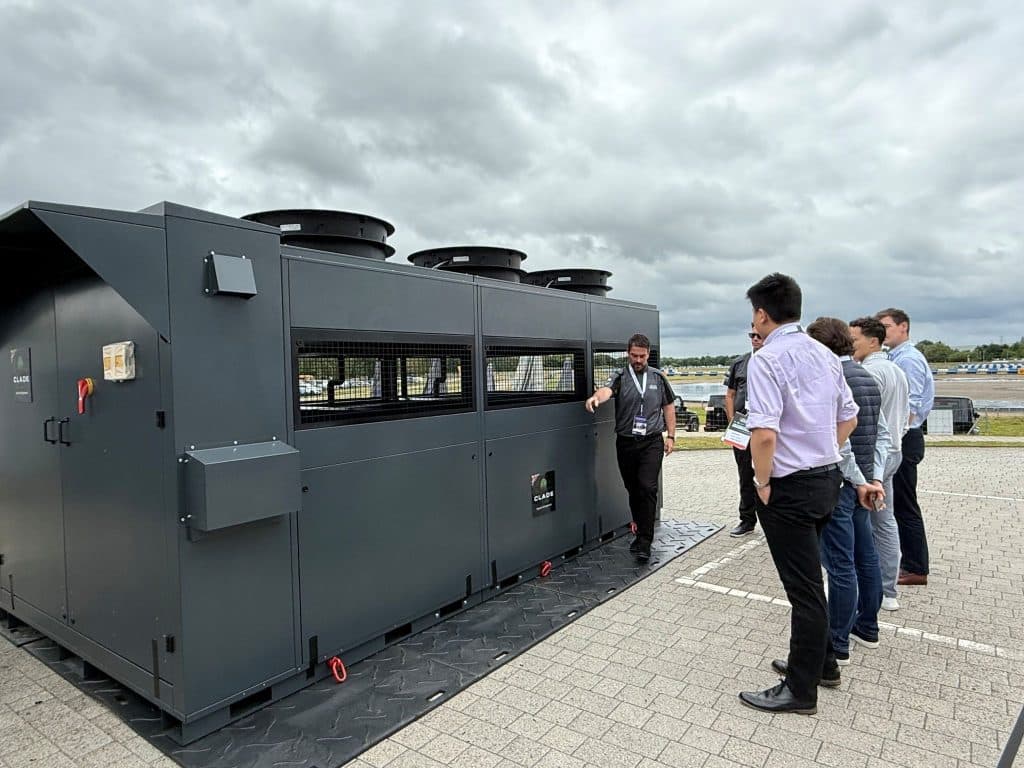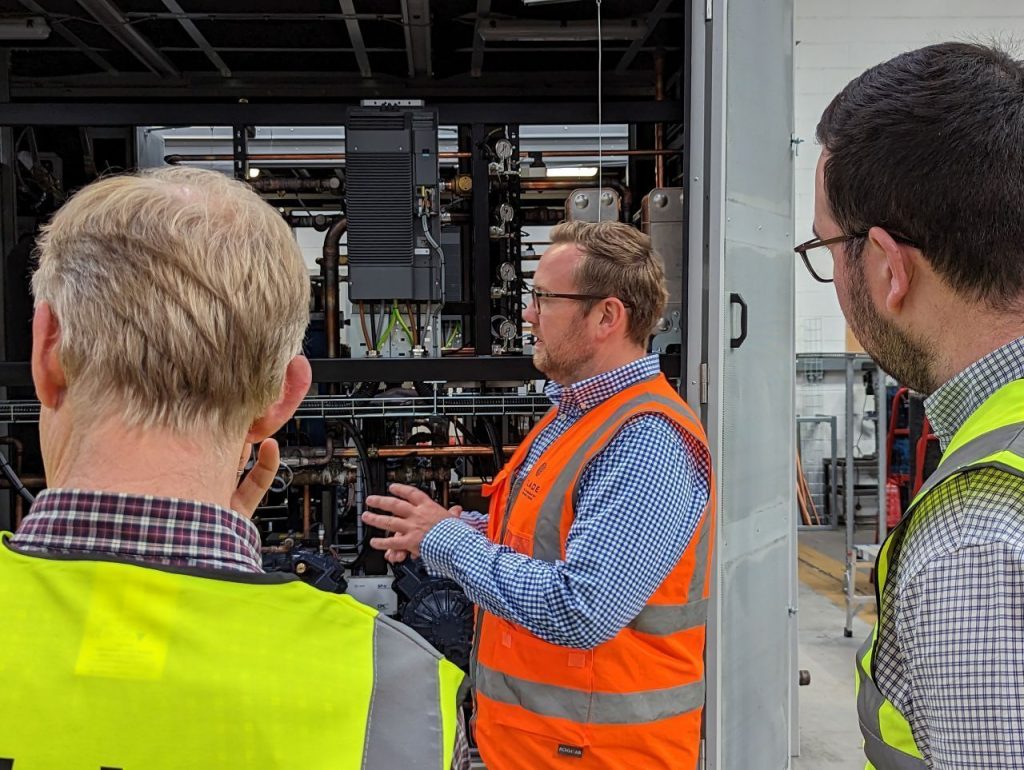Airflow and layout in heat pumps: going above and beyond

At Clade, we’re proud to be at the front of the curve when it comes to heat pump technology.
So, we’re constantly working to make improvements to all aspects of our commercial heat pumps.
In particular, there are two key elements that we don’t talk much about. But that’s because we’re constantly squirreling away at them behind the scenes: airflow and layout.
Here, I’ll give you the lowdown on both, and share some of the ways we’re going above and beyond in these areas.
Layout
When it comes to heat pump layout, there are two key aspects to mention.
There’s the internal layout of our heat pump units, but also the layout of a client’s heat pump system on-site.
The two often go hand-in-hand. So, we’re constantly seeking feedback from our clients and teams on the ground to figure out how we can improve our products to better meet client needs.
Here are some of the main considerations.
Space
First things first, clients often have their own requirements when it comes to space.
Often, you’ll only have a set amount of space available on-site where you can locate a heat pump unit (especially with the other equipment that may be required alongside it!).
With that in mind, when we design new products, we’re often looking for ways that we can reduce their size to meet demand from clients – as well as ways that we can offer different orientation packs so that units can be located more easily on site.
However, we can also work with clients to create more bespoke solutions that meet their specific needs.
For instance, clients often get in touch saying that they need a unit of a specific capacity that also fits within a certain footprint. If we don’t yet have a unit that meets these requirements, we’re often able to work together to create a bespoke solution for them.
Serviceability
Serviceability isn’t always top of a client’s mind during the design and installation process.
However, making sure that the layout of our units allows for easy servicing and maintenance can make a huge difference to our clients’ experience with our products in the long run.
This includes things like:
- Being able to easily access oil separators to view oil levels
- Making sure that PRVs are easy to access and replace
- Easy access to compressor electrical containment for maintenance
We’ve recently been working on making our compressors more accessible by putting them on runners so they can be easily pulled out.
Likewise, heat exchangers are widely regarded as components that are largely unserviceable. But we’ve been looking at ways they can be swapped out more easily so that, if a client does lose a heat exchanger, it’s not so detrimental to the product.
Safety
Another key focus for us at the moment is providing a more detailed overview to clients in terms of how they can create a safe layout for their heat pump system on site.
Heat pumps have a pressure relief valve (PRV) to release pressure in the system and prevent pipework from bursting if there’s a fault and temperatures start rising.
Plus, there’s always a (small) chance that there’s a fault that can cause refrigerant to leak from the unit, even when it isn’t running. This could be a safety concern, especially when it comes to the refrigerant R290, which is flammable.
With this in mind, it’s important to consider where units are located, and to put zones in place around them (and particularly around PRVs) where there aren’t any potential sources of ignition – like electric core devices.
By releasing in-depth information from our side and anticipating what other equipment is likely to be added on-site, we can help clients to confidently plan the layout of their site with safety in mind.
Airflow
Airflow is another important aspect that’s often top of our mind here at Clade.
Here are the main considerations to take into account when we’re playing with airflow and honing our heat pump units.
Noise
We talk about noise a lot – both internally and on our blog. In fact, our Chief Technical Officer, Chris Bassford, has previously penned a blog sharing his in-depth insights about heat pumps and noise.
But what we don’t often talk about is how airflow and noise are intrinsically linked.
This is because much of the noise output you’ll get from a heat pump is related to the acoustic noise outbreak of the fan running.
At the moment, we have two key focuses in trying to mitigate against this.
1. Diffusers
A diffuser is a cone-like piece of equipment that sits on top of fans to help control the airflow coming off them.
When air passes over a heat pump fan, it moves in a circular motion, which can create a fair bit of noise. However, a diffuser can help it to maintain a more laminar flow to reduce noise output.
Using diffusers on heat pump units could reduce the noise of a fan by three or four decibels.
While that may not sound like a lot, it can make a big difference when it comes to lowering noise (and therefore meeting planning requirements) while still maintaining the airflow required.
2. Housing
We’re also currently looking at making changes to our units’ housing, in partnership with our housing manufacturer.
All Clade units are fully contained in compressor housing.
We’re exploring how we can use dense acoustic materials to contain noise within the housing, which is inclusive of the fans at source.
In this way, we’ll be preventing noise from propagating, and we’ll be dampening the level of sound that’s audible to people around the machine. This could be a gamechanger in noise-critical applications, such as when we’re installing heat pumps in residential areas.
Thermal performance
There’s always a drive to make heat pumps as small as possible so that they can fit in places with limited space available – like rooftops.
In order to make this possible, we need to maximise thermal performance.
In other words, we need to generate as much heating capacity as possible within the space envelope available.
This is when we start getting innovative with heat exchanger and airflow designs.
One of our newest solutions is replacing a traditional flatbed coil with a V-block design.
Essentially, this allows us to maximise the space available inside the unit to squeeze in what is, in effect, two heat exchangers, rather than just one, in a V configuration.
This way, we’re practically doubling the surface area of the heat exchanger without increasing the product’s space envelope, which comes with massive benefits.
Either, it allows us to generate more heat capacity. Or, it allows us to generate the same heat capacity as with a single heat exchanger while running the fans at a lower speed, thereby reducing noise.
Our Acer 2 CO2 heat pump and Elm 2 R290 heat pump are two of our latest releases featuring this V-block design and actively boosting thermal performance for our clients.
Understanding airflow behaviour
Airflow can behave differently on different sites, depending on various obstructions or restrictions.
As an example, a recent client wanted to put our heat pumps in an undercroft car park – which means low-level ceilings and walls on either side of the units.
The risk here is that air that’s been rejected by our heat pump could end up recirculating into the machine.
This could result in a vicious cycle where cold air is constantly being rejected out of the top of the machine and circulated back onto the evaporator coil, getting to a point where the temperature coming onto the coil is so low that the machine would stop working.
On the other hand, ensuring that there’s adequate space above units to allow the airflow that’s rejected to mix with the warmer ambient air helps prevent operational issues.
This shows how understanding airflow behaviour can help designers and clients anticipate problems and ensure a high-performing system.
At Clade, we provide recommendations based on good practice, R&D testing, and empirical evidence from past heat pump projects.
However, clients can also carry out a CFD (Computational Fluid Dynamics) analysis to get a deeper insight. This involves using computational models to better understand how airflow might behave when applying our heat pump onto a specific site with certain restrictions, and can be particularly helpful if there are unusual obstacles on-site.
Talk to us about airflow and layout
As you can see, there’s a lot more to airflow and layout than initially meets the eye.
But it’s not something that you necessarily need to worry about.
Instead, you can let our experienced team of engineers here at Clade worry about it for you – from the design and manufacturing phase, all the way up to installation, commissioning and servicing.
With over 35 years of experience working with natural refrigerant heat pump and refrigeration systems, we know the ins and outs of airflow and layout like the backs of our hands.
And we’re constantly looking for new ways to innovate in these areas, to make life easier for our teams and clients on the ground.
Just get in touch to learn more and get your project started.

